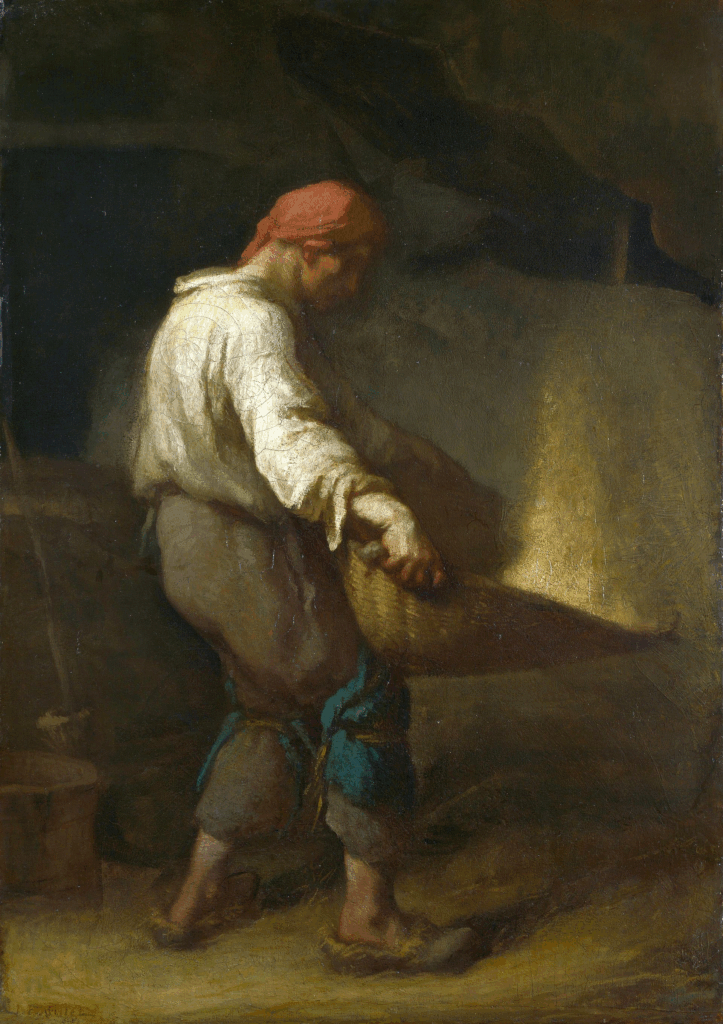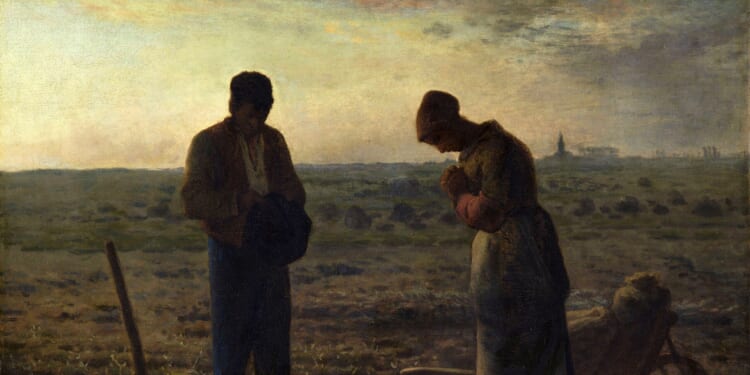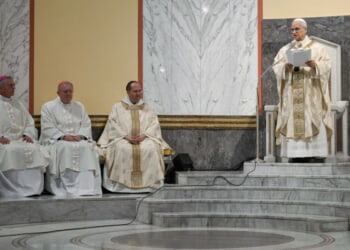More than many artists, Jean-François Millet (1814–75) has had his reputation made by others. Responses to his work from both admirers and detractors offer a range of impressions, preventing a definitive assessment. Despite the rise of industrialization and its seismic implications, it was Millet, with the rustic environment, rural labor, and a seasonal way of life as his major subjects, who became one of the defining figures of nineteenth-century art.
“Millet: Life on the Land,” at London’s National Gallery, marks the hundred and fiftieth anniversary of the artist’s death and comprises a selection of oils and drawings. Presenting works that depict sowing and woodcutting, these are accompanied by the centerpiece loan of L’Angélus from the Musée d’Orsay, a section on women at work, and scenes of wood gathering.
Born into a family from the upper echelon of the peasantry, Millet received an exceptional education that included Latin and a thoroughgoing appreciation of the Louvre art collection. The well-read Millet is known to have studied the writings of Vasari and Poussin. As with his near contemporary Courbet, a turn towards peasant subjects and a more mature style came in the aftermath of France’s 1848 revolution.
While Courbet became associated with explicit political engagement and bohemianism, Millet was not an unequivocal dissident. Neither reactionary nor revolutionary, his politics lacked the extremity of Delacroix’s and Courbet’s; perhaps this is why the reaction to his pictures has ranged so widely, resulting in praise and criticism from figures across the political spectrum.
Van Gogh once wrote that it was Millet rather than Manet who most expressed the essential nature of modern painting. Millet’s work was produced at a time of considerable evolution in the arts, including the reappraisal of neglected artists such as the Le Nain brothers and a declining following for Neoclassicism and Romanticism.
Millet’s peasant identity endured during his time in Paris, a city which did not favor him. Financial woes persisted, with desirable commissions hard to come by; he lived in a garret producing marketable nudes and found work painting signs. He ended up rejecting the capital, choosing instead to move to the village of Barbizon, where depicting the rural world became almost the entire focus of his art.
His treatment of workers, a subject so infused with history, has aroused impassioned responses. Some of the most prominent of these were critical, accusing the artist of sentimentality towards a land laboring class. Through his now-archetypal images of peasant life, however, Millet gained devotees who felt that his work revealed the revolutionary potential of manual laborers.
The surfeit of debate and fame surrounding Millet’s paintings is largely absent from his drawings. Nonetheless, the latter were a major part of his practice and often served as the basis for his oils. The selection in this exhibition comprises a series of shepherdess figures, wood-splitting laborers, and a plough scene.
Millet’s most characteristic pictures offer a well-measured rejection of artifice, combined with a sincere response to nature, an instinct evident in the quotations he wrote down from writers such as Montaigne and the Brontë sisters. His preference for more “primitive” or direct techniques found further inspiration in the works of Pieter Bruegel the Elder and in sixteenth- and seventeenth-century Northern European prints.
It’s tempting to see his move from Paris to the country as another manifestation of this conviction. Above all, it was a return to the familiar and allowed for a proximity to the Arcadian qualities he had found in literature and his early life.
From the National Gallery’s own collection, The Winnower (1847–48) serves as a prompt for this show. Bought by a republican politician in the immediate aftermath of King Louis-Philippe’s abdication, it was a critical success when shown in 1848.

Jean-François Millet, The Winnower, 1847–48. Oil on canvas, The National Gallery, London.
Despite Millet’s rejection of salon culture, his avid reading of Homer, Virgil, and Dante, among others, together with the tradition of drawing from the antique, provided him with a solid and abiding base. His stolid, defiantly monumental, and sculptural images of peasants replace the traditional subjects of religious imagery, grand history, and academic classicism.
L’Angélus (1857–59) is one of Millet’s most recognizable and most referenced paintings. Against a sunset, a couple is pictured at rest amid the harvest; the woman is at prayer while the man looks down with a more ambiguous expression. The work is this exhibition’s major loan and since its creation has induced fascinating reactions from artist and critic alike. For Camille Pissarro it was a work of unpardonable sentimentality, whereas Dalí, probably the painting’s most publicized admirer, found in the image a violent sexuality which proved an enduring source for his own work.
An observation by the art critic Jules-Antoine Castagnary may further help define Millet’s emphasis on the pastoral world: to make new discoveries, artists were seeking spaces still free of urbanization and its accompanying decay. Commentators have drawn parallels between Millet’s work and that of Poussin and Michelangelo, the former for theme and the latter for figurative handling and monumentality. Religious traces remain while carefully manipulated classical motifs are combined with aspects of contemporary working-class life.
Millet knew the hardships of peasant existence; he had also experienced city life and abandoned it for the environment that stirred him most. In the pictures here, when laborers are not depicted alone, they are not looking at each other. They are not shown in domestic scenes or at play. In an oil, The Faggot Gatherers (1868–75), facial features are barely discernible.
This is Millet’s first solo show in the United Kingdom in almost fifty years, and even now with a relatively small selection of works. The arrangement of pictures in this concentrated exhibition offers a consistent and resigned impression, suggestive of the melancholy disposition said to beset the artist. Regardless of whether his aim was to convey peasant toil with disinterest or to induce resistance to this suffering, Millet produced some of the most significant pictures of mid-nineteenth-century life. His vision of laboring life is darker than often realized and, in this exhibition, upheld with a fatalistic stoicism.


















